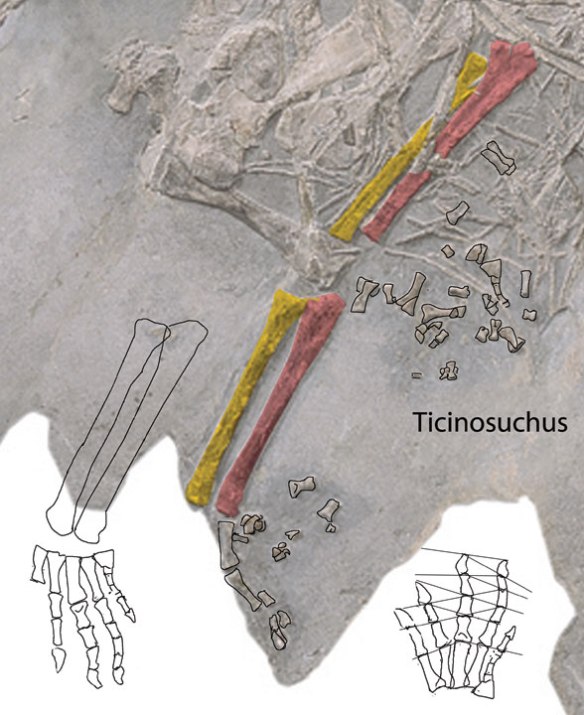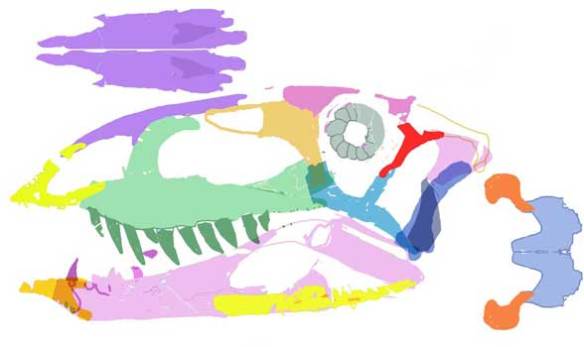Except for
the skull of Ticinosuchus ferox (Krebs 1965; Middle Triassic, ~ 230 mya, ~3 m in length), I have been using the traditional Krebs reconstruction for the post-crania. Here (Fig.1 ) I finally present my own tracing and reconstruction of Ticinosuchus.

Figure 1. Aetosaurus, Stagonlepis and Ticinosuchus shown together to scale. Ticinosuchus is the basalmost taxon in this clade, unrecognized by other cladograms. Perhaps this is due to differences in skull reconstructions. Note the phylogenetic miniaturization at the origin with Aetosaurus.
The morphological differences
between the Krebs and present reconstructions are few. However the posture here (Fig. 1) is a little more sacrum high, based on the long robust hind limbs, as also seen in Stagonolepis (Fig.1). Earlier we looked at the sharp premaxilla in Ticinosuchus that was previously overlooked by all workers. It’s a key trait shared with aetosaurs (Fig. 2).
Historical Notes from Nesbitt 2011
“Krebs (1963, 1965) argued that Ticinosuchus and Rauisuchus were more closely related to crocodylians than to any other group—a view that was opposed by various workers (e.g., Hughes, 1963; Romer, 1966, 1972b; Bonaparte, 1982) who thought that rauisuchids were proterosuchians.”
“Bonaparte (1981, 1984), placed Rauisuchus, Fasolasuchus, Prestosuchus, Saurosuchus, Ticinosuchus and various other fragmentary forms into Rauisuchidae.”
Nesbit 2011
identified the angular premaxilla as a questionable lacrimal. No reconstruction was offered to support this arrangement. He nested Ticinosuchus in a polygamy with a wide range of taxa including Revuletosaurus + Aetosauria, Turfanosuchus, Gracilisuchus, Qianosuchus and Prestosuchus.
Revueltosaurus?
Nesbitt 2011 nested Revueltosaurus at the base of the aetosaurs. The large reptile tree nests Revueltosaurus with Tasmaniosaurus and Fugusuchus (Fig. 3), altogether a sister clade to the Erythrosuchia and not far from Euparkeria. Revueltosaurus has a round premaxilla.
References
Krebs B 1965. Ticinosuchus ferox nov. gen. nov. sp. Ein neuer Pseudosuchier aus der Trias des Monte San Giorgio. Schweizerische Palaontologische Abhandlungen 81:1-140.
Lautenschlager S and Desojo JB 2011. Reassessment of the Middle Triassic rauisuchian archosaurs Ticinosuchus ferox and Stagonosuchus nyassicus. Paläontologische Zeitschrift Online First DOI: 10.1007/s12542-011-0105-1
Nesbitt SJ 2011. The early evolution of archosaurs: relationships and the origin of major clades. Bulletin of the American Museum of Natural History 352: 292 pp.






